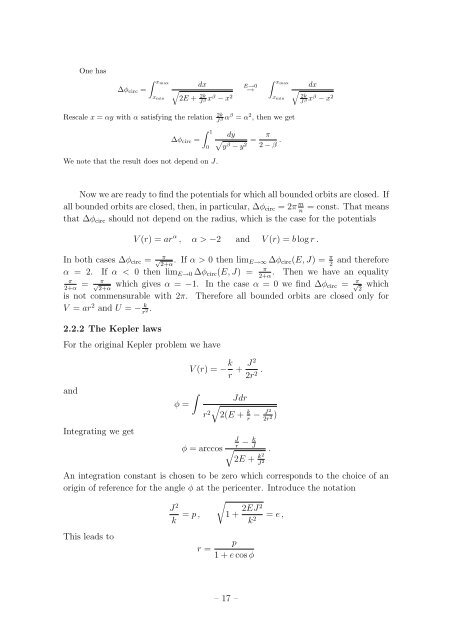Student Seminar: Classical and Quantum Integrable Systems
Student Seminar: Classical and Quantum Integrable Systems
Student Seminar: Classical and Quantum Integrable Systems
You also want an ePaper? Increase the reach of your titles
YUMPU automatically turns print PDFs into web optimized ePapers that Google loves.
One has<br />
∆φ circ =<br />
∫ xmax<br />
x min<br />
dx<br />
√<br />
2E + 2k x<br />
J β − x 2<br />
β<br />
E→0<br />
→<br />
∫ xmax<br />
x min<br />
dx<br />
√<br />
2k<br />
x<br />
J β − x 2<br />
β<br />
Rescale x = αy with α satisfying the relation 2k<br />
J β α β = α 2 , then we get<br />
∆φ circ =<br />
∫ 1<br />
We note that the result does not depend on J.<br />
0<br />
dy<br />
√<br />
yβ − y = π<br />
2 2 − β .<br />
Now we are ready to find the potentials for which all bounded orbits are closed. If<br />
all bounded orbits are closed, then, in particular, ∆φ circ = 2π m = const. That means<br />
n<br />
that ∆φ circ should not depend on the radius, which is the case for the potentials<br />
V (r) = ar α , α > −2 <strong>and</strong> V (r) = b log r .<br />
In both cases ∆φ circ = √ π<br />
2+α<br />
. If α > 0 then lim E→∞ ∆φ circ (E, J) = π <strong>and</strong> therefore<br />
2<br />
α = 2. If α < 0 then lim E→0 ∆φ circ (E, J) = π . Then we have an equality<br />
2+α<br />
π<br />
= √ π<br />
2+α 2+α<br />
which gives α = −1. In the case α = 0 we find ∆φ circ = √ π 2<br />
which<br />
is not commensurable with 2π. Therefore all bounded orbits are closed only for<br />
V = ar 2 <strong>and</strong> U = − k .<br />
r 2<br />
2.2.2 The Kepler laws<br />
For the original Kepler problem we have<br />
<strong>and</strong><br />
Integrating we get<br />
∫<br />
φ =<br />
V (r) = − k r + J 2<br />
2r 2 .<br />
Jdr<br />
√<br />
r 2 2(E + k − J 2<br />
)<br />
r 2r 2<br />
φ = arccos<br />
J<br />
√ − k r J<br />
.<br />
2E + k2<br />
J 2<br />
An integration constant is chosen to be zero which corresponds to the choice of an<br />
origin of reference for the angle φ at the pericenter. Introduce the notation<br />
√<br />
J 2<br />
k = p , 1 + 2EJ 2<br />
= e ,<br />
k 2<br />
This leads to<br />
r =<br />
p<br />
1 + e cos φ<br />
– 17 –

















